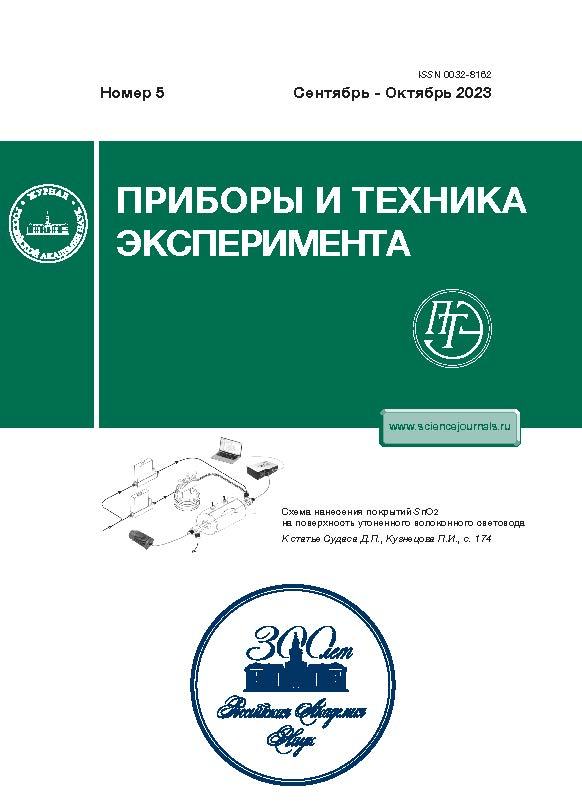Enhancing the Temperature-Measurement Efficiency in the Brillouin Optical Time-Domain Reflectometry (BOTDR) Fiber Sensor with the K-nearest Neighbor (K-NN) Algorithm
- Авторлар: Almoosa A.S.1,2, Zan M.S.1, Ibrahim M.F.1, Arsad N.1, Mokhtar M.H.1, Bakar A.A.1, Konstantinov Y.A.3
-
Мекемелер:
- Department of Electrical, Electronic, and Systems Engineering, Faculty of Engineering and Built Environment, National University of Malaysia (UKM)
- Department of Electronic Technologies, Basra Technical Institute, Southern Technical University
- Perm Federal Research Center, Ural Branch, Russian Academy of Sciences (PFRC UB RAS)
- Шығарылым: № 5 (2023)
- Беттер: 40-47
- Бөлім: ОБЩАЯ ЭКСПЕРИМЕНТАЛЬНАЯ ТЕХНИКА
- URL: https://cardiosomatics.ru/0032-8162/article/view/670411
- DOI: https://doi.org/10.31857/S0032816223050270
- EDN: https://elibrary.ru/LHLMAP
- ID: 670411
Дәйексөз келтіру
Аннотация
The authors propose to use the K-nearest neighbor (K-NN) algorithm to process the probe signals from the previously proposed Brillouin optical time-domain reflectometry (BOTDR) fiber sensor called the differential cross-spectrum BOTDR (DCS-BOTDR), which features a high spatial resolution. Widening of the Brillouin gain spectrum (BGS) when the pulse duration TL is set shorter than the phonon lifetime (~10 ns) is a key problem associated with the DCS-BOTDR. Although the spectrum distortion is reduced also, deterioration in the Brillouin frequency shift (BFS) resolution is observed, which is caused by the broadening of the Brillouin spectrum. On the other hand, while the TL duration exceeding the steady state of the Brillouin signal narrows the spectrum, sidelobes are produced within the steady-state range, which result in the deterioration of the BFS resolution. This limitation is observed only in the DCS-BOTDR, although it is capable of measuring with a high spatial resolution. The experimental data obtained for a fiber with a length of ~400 m and with optimized TL duration in the temperature range of 40–80°C were used in our model to extract the Brillouin temperature coefficient CT. Ideal BGSs were then constructed in the training phase by simulation with different linewidths of 50–70 MHz in order to train the K-NN model with due account for the linewidth variation caused by the difference in the conditions between the training and testing phases. The model was thereby made flexible for various fiber conditions. Experimental data for the sensing of a ~3.6-km-long fiber with TL = 60 ns were used in the testing phase to obtain the temperature distribution. By employing K-NN, the accuracy in determining the temperature for TL = 60 ns has been improved to approximately 2.77°C. Therefore, the K-NN model can be an excellent alternative tool for processing BGSs measured by the DCS-BOTDR and obtaining the temperature distribution along the fiber.
Авторлар туралы
Ahmed Almoosa
Department of Electrical, Electronic, and Systems Engineering, Faculty of Engineering and Built Environment, National University of Malaysia (UKM); Department of Electronic Technologies, Basra Technical Institute, Southern Technical University
Email: ahmedsabri1988@gmail.com
43300, Selangor, Bangi, Malaysia; 61001, Basra, Iraq
Mohd Zan
Department of Electrical, Electronic, and Systems Engineering, Faculty of Engineering and Built Environment, National University of Malaysia (UKM)
Email: yuri.al.konstantinov@ro.ru
43300, Selangor, Bangi, Malaysia
Mohd Ibrahim
Department of Electrical, Electronic, and Systems Engineering, Faculty of Engineering and Built Environment, National University of Malaysia (UKM)
Email: yuri.al.konstantinov@ro.ru
43300, Selangor, Bangi, Malaysia
Norhana Arsad
Department of Electrical, Electronic, and Systems Engineering, Faculty of Engineering and Built Environment, National University of Malaysia (UKM)
Email: yuri.al.konstantinov@ro.ru
43300, Selangor, Bangi, Malaysia
Mohd Mokhtar
Department of Electrical, Electronic, and Systems Engineering, Faculty of Engineering and Built Environment, National University of Malaysia (UKM)
Email: yuri.al.konstantinov@ro.ru
43300, Selangor, Bangi, Malaysia
Ahmad Bakar
Department of Electrical, Electronic, and Systems Engineering, Faculty of Engineering and Built Environment, National University of Malaysia (UKM)
Email: yuri.al.konstantinov@ro.ru
43300, Selangor, Bangi, Malaysia
Yu. Konstantinov
Perm Federal Research Center, Ural Branch, Russian Academy of Sciences (PFRC UB RAS)
Хат алмасуға жауапты Автор.
Email: yuri.al.konstantinov@ro.ru
614990, Perm, Russia
Әдебиет тізімі
- Bai Q., Wang Q., Wang D., Wang Y., Gao Y., Zhang H., Zhang M., Jin B // Sensors. 2019.V. 19. P. 1862. https://doi.org/10.3390/s19081862
- Bao X., Chen L. // Sensors. 2012. V. 12. P. 8601. https://doi.org/10.3390/s120708601
- Hartog A.H. An introduction to distributed optical fibre sensors. CRC press. 2017. https://doi.org/10.1201/9781315119014
- Almoosa A.S.K., Hamzah A.E., Zan M.S.D., Ibrahim M.F., Arsad N., Elgaud M.M. // Opt. Fiber Technol. 2022. V. 70. P. 102860. https://doi.org/10.1016/j.yofte.2022.102860
- Zan M.S.D. et al. // Opt. Fiber Technol. 2022. V. 72. P. 102977. https://doi.org/10.1016/j.yofte.2022.102977
- Zan M. et al. // J. Physics: Conference Series 2021. V. 1892. P. 012034. https://doi.org/10.1088/1742-6596/1892/1/012034
- Koyamada Y., Sakairi Y., Takeuchi N., Adachi S. // IEEE Photonics Technol. Lett. 2007. V. 19. P. 1910. https://doi.org/10.1109/LPT.2007.908651
- Nishiguchi K.I., Li C.-H., Guzik A., Kishida K. // Sensors. 2014. V. 14. P. 4731. https://doi.org/10.3390/s140304731
- Horiguchi T., Masui Y., Zan M.S.D, // Sensors. 2019. V. 19. P. 1497. https://doi.org/10.3390/s19071497
- Shibata R., Kasahara H., Elias L.P., Horiguchi T. // IEICE Electron. Express. 2017. P. 14.20170267. https://doi.org/10.1587/elex.14.20170267
- Zan M.S.D., Masui Y., Horiguchi T. // In 2018 IEEE 7th International Conference on Photonics (ICP). 2018. P. 1. https://doi.org/10.1109/ICP.2018.8533208
- Bansal M., Goyal A., Choudhary A. // Decision Analytics J. 2022. V. 3. P.100071. https://doi.org/10.1016/j.dajour.2022.100071
- Chaplot N., Dhyani P., Rishi O. // Inter. J. Comput. Sci., Engin.& Technol. 2013. V. 1. P. 12. Corpus ID: 173168717
- Nordin N.D., Zan M.S.D., Abdullah F. // Opt. Fiber Technol. 2020. V. 58. P. 102298. https://doi.org/10.1016/j.yofte.2020.102298
Қосымша файлдар



















